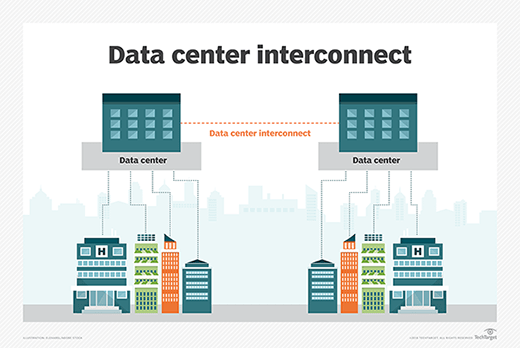What is data center interconnect (DCI)?
Data center interconnect (DCI) technology links two or more data centers so they can share resources. Many options for DCI connectivity exist. The selection process depends on a wide range of variables, including the following:
- The location of the data centers.
- The distance between data centers.
- Bandwidth and availability requirements.
- The capabilities of local service providers.
- Security concerns.
Previously, companies primarily used interconnection to support business continuity and disaster recovery (BCDR). Today, that use has shifted to include day-to-day operations. This enables data center operators to manage their resources and support key load-balancing functions. DCI technology is critical to help enterprises scale their infrastructure as internet traffic grows and cloud migration becomes vital.
Private cloud migration has created new network traffic flows. Before, companies managed north-south traffic -- information coming in from outside the data center. Now, they mange more east-west traffic -- data moving from one data center system to another. To handle this type of traffic, data centers need fewer external connections and more DCIs.
For public cloud vendors, application migration toward third-party services also drives the need for DCIs. Cloud providers are building hyperscale data centers, which constantly need more bandwidth and capacity to accommodate traffic.

Benefits of DCI
DCI provides several benefits. It lets organizations share resources by dynamically tapping into physical and virtual resources across multiple sites, enabling them to load balance their network infrastructures as needed. DCI links enable stronger traffic encryption, making information sharing more secure. This helps with stronger BCDR and improves security.
DCI also enables companies to apply quality of service and other policies to ensure performance. With DCI, organizations have more flexibility when they allocate workloads because the technology supports multiple connection types.
Data center interconnect options
DCIs connect data centers over short and long distances. Organizations should consider various applications to build interconnections over high-speed Ethernet or optical interfaces on dedicated fiber or wavelength services.
DCI requires a high-speed wide area network (WAN) link, including Multiprotocol Label Switching, Ethernet and virtual private local area network service. Metro Ethernet is an option to connect data centers within an urban setting. Each option offers high bandwidth, low latency, and Layer 2 or Layer 3 access among data centers.
Enterprises can use WAN optimization appliances on each endpoint to use transfer protocols and compress traffic volume, further enhancing DCI. Another option is using dense wavelength-division multiplexing technology to extend the long-distance connection among data centers.







